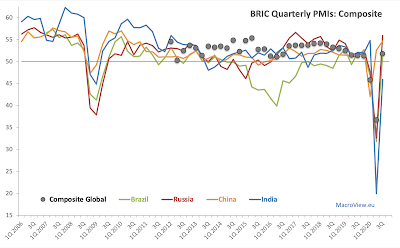BRIC - Brazil, Russia, India and China - economies have posted a significant improvement in Q3 Purchasing Managers Indices in Manufacturing sector:
Brazil Manufacturing PMI rose to 62.6 - the highest on record in 3Q 2020 following 42.0 recessionary reading in 2Q 2020. This is a massive rebound from pandemic lows, and the level of 3Q reading puts into question validity or accuracy of the surveys. On a monthly basis, the index was at 64.7 and 64.9 in August and September. Brazil's manufacturing index was at sub-50 readings in March-May 2020, with a reasonably credible rebound in June and July. August and September readings are literally out of the ball park, both in terms of historical comparatives and in terms of past turning points from recessions to expansions.
Russia Manufacturing PMI treaded water in 3Q 2020, swinging from 48.4 in July to 51.1 in August and back to 48.9 in September. As the result, Russia posted sub-50 reading for 3Q 2020 at 49.5, the only BRIC economy in this position. This marks 5th consecutive quarter of sub-50 PMIs. Statistically, the last time Russian manufacturing was in the expansion territory was in 1Q 2019.
India Manufacturing PMI rose strongly in Q3 2020 to 51.6, well above 35.1 recession trough in Q2 2020. However, statistically, current reading signals relatively weak recovery. September monthly index came in at more robust 56.8, suggesting that the economy may be gathering some momentum and recovery may be accelerating.
China Manufacturing PMI was basically unchanged at 53.0 in September compared with 53.1 in August. 3Q 2020 PMI is at 53.0, which is an improvement on statistically zero growth reading of 50.4 in 2Q 2020. China's Manufacturing PMI numbers are historically less volatile, so 53.0 marks the fastest pace of expansion since 4Q 2010.
Overall, GDP-weighted BRIC Manufacturing Activity Index stood at 53.0 in 3Q 2020, above the Global Manufacturing Index (51.6) and up on 45.0 in 2Q 2020.





























